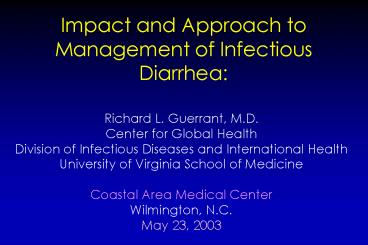Impact and Approach to Management of Infectious Diarrhea: PowerPoint PPT Presentation
1 / 4
Title: Impact and Approach to Management of Infectious Diarrhea:
1
Impact and Approach to Management of Infectious
Diarrhea
Richard L. Guerrant, M.D. Center for Global
Health Division of Infectious Diseases and
International Health University of Virginia
School of Medicine Coastal Area Medical
Center Wilmington, N.C. May 23, 2003
2
Impact and Approach to Management of Infectious
Diarrhea
- Participants should be able to
- Understand the global importance of diarrheal
diseases - Know the frequency, setting and risk factors for
specific enteric infections - Determine when to obtain which selected
diagnostic tests - Manage common diarrheal illnesses, knowing risks
and benefits of antibiotics and antimotility
agents.
Suggested readings Guerrant et al Practice
Guidelines for the Management of Infectious
Diarrhea. Clin Inf Dis 32 331, 2001. Blaser et
al Infections of the GI Tract. Raven Press, NY,
1995. Wong et al The risk of HUS after antibiotic
treatment of E. coli O157H7 infections. NEJM
342 1930, 2000. Chandler et al. Prothrombotic
coagulation abnormalities preceding the HUS.NEJM
346 23, 2002. Safdar et al. Risk of HUS after
antibiotic treatment of E. coli O157 a
meta-analysis. JAMA 288 996, 2002.
3
Summary of Recommendations for Managing
Infectious Diarrhea
QE/SR 1. Initial
rehydration (ORT) I/A 2. Clin/Epi eval (onset,
Sx, travel, DCC, raw meat/seafood/ II/A milk,
others, sex, meds, other conditions, etc) 3.
Selective fecal studies II/B 4. Selective
therapy (Travelers, shigellosis, I/A C.
jejuni) II/B 5. Avoid antimotility drugs
(bloody d, proven STEC) II/E 6. Typhoid
(cholera) vaccines (travelers/residents) II/B
QEquality of evidence SRstrength of
recommendation
Guerrant et al IDSA Guidelines CID 32 331-350,
2001
4
Approach to diagnosis and management of diarrheal
illnesses
Evaluate severity
and duration
Obtain history and physical examination 1-5
Treat
d
ehydration
6
Report suspected
outbreaks
7
Check all that apply
Seafood or seacoast exposure should prompt
culture for Vibrio sp.
1
Traveler's diarrheal illnesses that have not
responded to empiric quinolone or SXT should have
above approach (A-D as indicated).
2
Persistent abdominal pain and fever should prompt
culture for Y. enterocolitica and cold
enrichment. Right-sided abdominal pain without
high fever with bloody or nonbloody
3
diarrhea should prompt culture for STEC O157.
Proctitis in symptomatic homosexual men can be
diagnosed by sigmoidoscopy. Involvement in the
distal 15cm only suggests herpesvirus,
gonococcal, chlamydial, or syphilitic
4
infection colitis extending more proximally
suggests Campylobacter, Shigella, C. difficile,
or chlamydial LGV serotypes infections, and
noninflammatory diarrhea suggests giardiasis.
Post diarrheal hemolytic uremic syndrome (HUS),
should prompt testing stools for STEC O157 and
for Shiga toxin (send isolates to reference lab
if toxin without STEC O157).
5
Outbreaks should prompt reporting to health
department. Consider saving culture plates and
isolates and freeze whole stools or swabs at
-70C.
6
Fecal lactoferrin testing or microscopy for
leukocytes can help document inflammation which
is often present in invasive colitis with
Salmonella, Shigella, Campylobacter, more
7
severe C. difficile colitis or with inflammatory
bowel disease.
Some experts recommend avoiding antimicrobial
agents in persons with bloody diarrhea in the
U.S.
8
Commonly used tests for parasitic causes of
diarrhea include fluorescence or enzyme
immunoassay for Giardia and Cryptosporidium
acid fast stains for Cryptosporidium,
9
Cyclospora, Isospora or Mycobacterium (also
culture for M. avium complex) and special
chromotrope or other stains for microsporidia as
noted in the text.
Guerrant et al. IDSA Guidelines, CID 32331, 2001.

